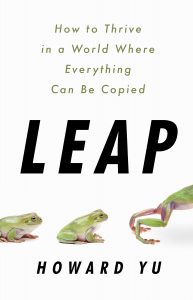Leaping to a New Growth Curve – Part 2 of 3

Recently I had the opportunity to interview Howard Yu, LEGO professor of management and innovation at the prestigious IMD Business School in Switzerland, director of IMD’s signature Advanced Management Program (AMP), and author of the book Leap: How to Thrive in a World Where Everything Can Be Copied to investigate a series of important questions about what we can learn from our history while looking to create our future. Without further ado, here is the transcript of that interview (Part 2 of 3):
5. What factors account for the incredible longevity and prosperity of pioneers in the pharmaceutical industry, particularly Switzerland’s Novartis?
Only when pioneers kept pace as the knowledge base shifted from one discipline to another, as they did in the pharmaceutical industry, were they able to exploit their opportunity and capitalize on their advantage.
But these leaps are fraught with challenges, even when one is armed with rich knowledge. No company can get it right every time. Those who have made it have done so with persistence, audacity, foresight, and sometimes luck. Precisely because this leap is very difficult, the most experienced companies stand a better chance of staying on top. Inventions and discoveries stand on the shoulders of their predecessors; hard-won progress is usually built on experience and prior knowledge.
When Novartis was on the cusp of developing its first targeted drug, Gleevec, which treats a rare form of leukemia, the transition to a new knowledge discipline, namely, bioengineering and genomics, was hardly straightforward.
The size of the market for the treatment for this rare form of leukemia (CML) appeared to be severely limited. CML affects about 8,200 American adults every year, a figure that pales in comparison with the estimated 165,000 cases of prostate cancer and 250,000 cases of breast cancer in the United States. Managers at Novartis were worried that the new drug would offer little financial return, in addition to the clinical uncertainties. The animal studies and clinical trials alone would cost the company between $100 million and $200 million.
It was the CEO who forged ahead with this development. “Ultimately, we are a business, and business decisions are often based on some form of statistical analysis and the chance to make a profit,†he admitted. “But, as a management team, when there is a fair chance that a product on the market will change the practice of medicine, we have a duty to put that product out there . . . I told our head of global technical operation, ‘Money doesn’t matter. Let’s just do it.’â€
To leap, the most challenging aspect has always been the impossibility of rendering investment decisions into positive financial forecasts. Only the one at the very top of the company can legitimately say, “Money doesn’t matter. Let’s just do it.â€
 6. In LEAP, you reveal the potential payoff for companies who have the courage to cannibalize their own products. What makes Procter & Gamble an outstanding model of successful self-cannibalization?
6. In LEAP, you reveal the potential payoff for companies who have the courage to cannibalize their own products. What makes Procter & Gamble an outstanding model of successful self-cannibalization?
When the first boxes of Tide went on sale in 1946, it was the first synthetic detergent that could deep-clean clothing—removing mud, grass, and mustard stains “without making colors dull or dingy.†Before Tide was introduced, all soaps were “natural†and made by heating animal or vegetable fats with water and an alkali base. The benefits of a synthetic detergent that makes “white clothes look whiter†were so apparent that Tide outstripped all brands in the market and became the number one detergent in 1949. In the wake of Tide’s entry to the market, P&G would “no longer be a soap company†but “would become an industrial corporation with its future based on technology,†with the number of technical staff tripling that of the pre-Tide year of 1945.
But inside P&G, a convulsive worry over research on synthetic detergent had historically been pervasive. Managers feared that the new products might cannibalize their much-cherished Ivory soap. Yet, Chairman William Cooper Procter, the last family manager of P&G, was a staunch supporter of the work on synthetic detergents. In a memorable remark addressed to his staff, he said, “This [synthetic detergent] may ruin the soap business. But if anybody is going to ruin the soap business, it had better be Procter & Gamble.†Management doubled down on its investment, and the technical center at Ivorydale effectively became one of the first analytical labs in the field of consumer goods. A family firm whose founders stirred cauldrons by hand had now become an enterprise built on three knowledge foundations: mechanical engineering, consumer psychology, and organic chemistry. And it was that combination—the totality of three knowledge disciplines—that had created the unstoppable Tide.
To an outside observer, one form of managerial behavior that was salient throughout the long history of P&G was apparent: the willingness to embrace self-cannibalization. Resistance to this counterintuitive strategy is natural. Managers often fear that a company’s new products and services with lower profit margins may directly cut into the sales of existing products. Money should be invested in products that are clearly most profitable without lowering overall profitability. But to reference a Steve Jobs almost cliché, “If you don’t cannibalize yourself, someone else will.â€
Novartis and P&G could not be more different. Novartis spends fearsome amounts of money designing and testing drugs for therapeutic treatment, jumping over the highest regulatory hurdles. P&G creates common household goods that clean. One saves lives; the other helps people look nice. Both companies, however, have thrived for more than a century; both have rewritten the rules in their respective sectors and transformed themselves, not just once but again and again.
 7. What can business leaders learn about reevaluating a company’s foundational strengths from the piano war between Steinway and Yamaha?
7. What can business leaders learn about reevaluating a company’s foundational strengths from the piano war between Steinway and Yamaha?
When industry knowledge matures, copycats catch up. Because latecomers often inherit a lower cost structure without the legacy assets, they exert competitive pressure on industry pioneers. That’s why Steinway can’t compete against Yamaha, even though it has always made the finest pianos in the world.
To more than 90% of concert artists, including such legendary virtuosos as Vladimir Horowitz, Van Cliburn, and Lang, a Steinway grand piano is the instrument of choice. Arthur Rubinstein, who is considered by many as the greatest pianist of the 20th century, once declared, “A Steinway is a Steinway, and there is nothing like it in the world.â€
Despite these remarkable achievements, over the past five decades Steinway’s financial results have been anything but stellar. Its management experienced crises one after another, which characterized a prolonged downward spiral. In 1926, Steinway sold 6,294 pianos, an all-time high; in 2012, it sold just over 2,000. The company changed ownership three times between 1972 and 1996—it was passed by Columbia Broadcasting System (CBS) to a group of private investors led by the brothers John and Robert Birmingham, and then to Selmer Industries, the number one instrument maker band in the United States. All these had already happened before Steinway went public in 1996, to be listed on the New York Stock Exchange, but then it went private when the hedge fund firm Paulson & Co. bought it for $512 million in 2013. Over the same period, Steinway helplessly auctioned off, one after another, many of its buildings that had historically been part of the Steinway Village in northern Astoria in Queens. The original 400-acre campus was slowly chipped away and eventually reduced to a gritty complex of a single redbrick factory building at the end of Steinway Street that we know today.
During post-war reconstruction, Yamaha, which was once an obscure manufacturer, focused on upright pianos to cater to the space-conscious Japanese, producing small home-use pianos that were infinitely different from the Steinway concert grand piano that graces Carnegie Hall or the Smithsonian museums. But inside Yamaha’s factory, manufacturing processes were all but automated, stamping out as much human interference as possible. A computerized system would identify pieces of veneer and direct them through overhead Y-shaped carriers to seven different rim presses, which corresponded to the different sizes of the grand pianos that Yamaha made. Only two employees were needed to guide the veneer to the correct position before a hydraulic cylinder came down with a pneumatic hiss and shaped it into the press. The rim adhesive would then dry in fifteen minutes, thanks to the high-frequency curing method. The entire process was designed with minimal variations in production, a system that couldn’t be more different from that of the heartbreakingly labor-intensive craftsmanship at Steinway and Sons.
By the time Yamaha entered the concert grand segment in 1966, it was already the largest piano builder in the world, with a production volume of 200,000 musical instruments every year, vastly overshadowing Steinway’s 6,000. With a far bigger balance sheet, a diverse set of technologies, and many advanced production techniques, Yamaha could marshal more resources in marketing, distribution, recruitment, and production. The money it gained from the low-end segment became the wellspring that allowed it to enter the top-end segment, the concert grand pianos, the “lifeblood†of Steinway.
Steinway’s difficulties might be mourned only by piano lovers, but there is a lesson in it for all of us. Managers must ask themselves what knowledge discipline is the most fundamental to their company. What is the core knowledge of their business? And how mature or widely available is it?
8. In LEAP, you urge both start-up entrepreneurs and corporate executives to leverage the seismic shifts around them and dive right into reconfiguring their competencies. Could you offer practical guidance for identifying forces on the horizon that will have a huge impact on a business?
To come up with an integrated strategy, every effective leader must begin with the big questions: What world am I living in? What are the biggest trends in this world? How do I align my company’s activities so that my organization gets the most out of these trends and cushions the worst? Part 1 of LEAP shows us the power of history, which acts as a prism that helps us understand the past so we can leap into new knowledge disciplines. Part 2 of LEAP takes us to the future to point out the two intertwining trends that propel all companies into the 21st century: the inexorable rise of intelligent machines and the emergence of ubiquitous connectivity. As new technologies are introduced, society is continuously transformed, and with it the way we will work in the future. We have observed that connectivity favors a decentralized mode of innovation, smart machines automate expert knowledge, and consequently, managerial activities that will still be ensconced in the human realm demand a higher level of creativity, social understanding, and empathy.
The inevitable is often quite apparent. Companies just need to leap while time is still on their side. Steve Jobs knew this. He said, “Things happen fairly slowly, you know. They do. These waves of technology, you can see them way before they happen, and you just have to choose wisely which ones you’re going to surf. If you choose unwisely, then you can waste a lot of energy, but if you choose wisely, it actually unfolds fairly slowly. It takes years.†Jobs was referring to the time that he waited for broadband for two years, and then when it finally arrived, he jumped into the window of opportunity by releasing the iPod. Countless others jumped earlier than Apple by releasing their own MP3 players but failed miserably. Before the 2000s, music sharing was virtually illegal—on Napster—and it took hours to download an album. With poor connectivity, even the best-designed hardware made was hopelessly sluggish when downloading. Jobs waited for the inevitable improvement of broadband.
This is an important lesson. Successful executives often exhibit a bias for action. But it’s more important to separate the noise from the signal that really pinpoints the glacial movement around us. Carefully listening to the right signals requires patience and discipline. Seizing a window of opportunity, which means not necessarily being the first mover but rather being the first to get it right, takes courage and determination. To leap successfully is to master these two seemingly contradictory abilities. A balanced combination of the discipline to wait and the determination to drive often pays off handsomely. Cultivating this paradoxical ability at the individual and organizational levels is the main objective of LEAP.
Final Words
LEAP began as a historical account, a memoir of Western pioneers. Some of these pioneers failed, some survived, others prospered. But it’s also a playbook for the future. More importantly, it’s a manifesto for how pioneering companies can rethink their businesses, their relationship with their customers, and the reasons they exist. Any organization — large or small — has a set of traditional strengths and important products that have helped build it into what it is today. There is no perfect moment to innovate. But everyone has exactly enough time, starting now.
Wait! Before you go…
Choose how you want the latest innovation content delivered to you:
- Daily — RSS Feed — Email — Twitter — Facebook — Linkedin Today
- Weekly — Email Newsletter — Free Magazine — Linkedin Group
 Braden Kelley is a popular innovation speaker, builds sustainable innovation cultures, and tools for creating successful change. He is the author of the five-star book Stoking Your Innovation Bonfire and the creator of a revolutionary new Change Planning Toolkit™. Follow him on Twitter (@innovate) and Linkedin.
Braden Kelley is a popular innovation speaker, builds sustainable innovation cultures, and tools for creating successful change. He is the author of the five-star book Stoking Your Innovation Bonfire and the creator of a revolutionary new Change Planning Toolkit™. Follow him on Twitter (@innovate) and Linkedin.
NEVER MISS ANOTHER NEWSLETTER!
LATEST BLOGS
Three things you didn’t know about credit cards
Photo by Ales Nesetril on Unsplash Many of us use credit cards regularly. From using them for everyday purchases to…
Read MoreFive CV skills of a business-minded individual
Photo by Scott Graham on Unsplash The skills listed on a CV help employers quickly understand your suitability for a…
Read More


